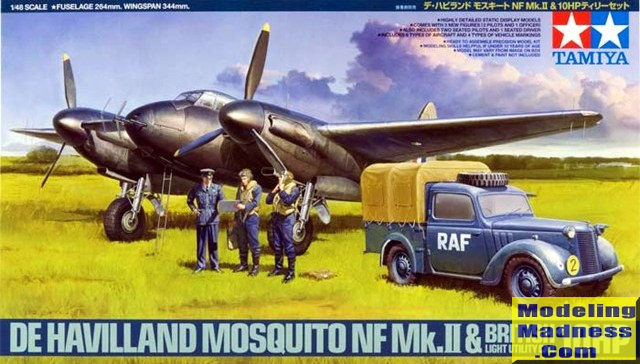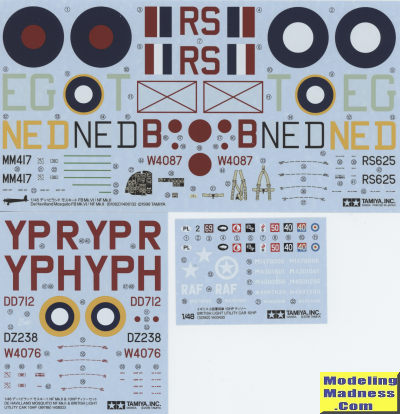
Tamiya 1/48 Mosquito NF.II & British 10hp Light Utility Car
| KIT #: | 89786 |
| PRICE: | 4600 yen SRP |
| DECALS: | Six options |
| REVIEWER: | Scott Van Aken |
| NOTES: | 2009 release |

| HISTORY |
At the end of 1940, the Air Staff's preferred turret-equipped night fighter design to Operational Requirement O.R 95 was the Gloster F.18/40 (derived from their F.9/37). However, although in agreement as to the quality of the Gloster company's design, the Ministry of Aircraft Production was concerned that Gloster would not be able to work on the F.18/40 and also the jet fighter design, considered the greater priority. Consequently, in mid-1941 the Air Staff and MAP agreed that the Gloster aircraft would be dropped and the Mosquito, when fitted with a turret would be considered for the night fighter requirement.
The first production night fighter Mosquitos - minus turrets - were designated NF Mk II. A total of 466 were built with the first entering service with No. 157 Squadron in January 1942, replacing the Douglas Havoc. These aircraft were similar to the F Mk II, but were fitted with the AI Mk IV metric wavelength radar. The herring-bone transmitting antenna was mounted on the nose and the dipole receiving antennae were carried under the outer wings. A number of NF IIs had their radar equipment removed and additional fuel tanks installed in the bay behind the cannon for use as night intruders. These aircraft, designated NF II (Special) were first used by 23 Squadron in operations over Europe in 1942. 23 Squadron was then deployed to Malta on 20 December 1942, and operated against targets in Italy.
Ninety-seven NF Mk IIs were upgraded with 3.3 GHz frequency, low-SHF-band AI Mk VIII radar and these were designated NF Mk XII. The NF Mk XIII, of which 270 were built, was the production equivalent of the Mk XII conversions. These "centimetric" radar sets were mounted in a solid "thimble" (Mk XII / XIII) or universal "bull nose" (Mk XVII / XIX) radome, which required the machine guns to be dispensed with.
| THE KIT |
Tamiya first released their Mosquito kit in 1998, much to the delight of fans of the type. They have since produced several other variants, but it was the Mk.II/VI which started things. Though touted as just the Mk.II on the box top, in fact, you get the complete Mk.II/VI kit, though it is molded in black plastic. Same instructions, same decals. Included with this boxing is the neat little truck that was a fixture at RAF bases in WWII.
I snagged this one from an on-line auction site and with shipping it was a quite reasonable price. One reason for this is that the box was rather heavily accordioned. While a sorry sight indeed, the interior bits seem to be no worse for the wear.
The kit offers several options, several of which are specifically for the night fighter or day fighter version. One can have open or flame dampened exhaust. Various holes need to be opened in the wings for the receive antennas or for the rocket rails typical on many Mk VI aircraft. One could also install bomb racks vice the rocket rails or leave them blank for the NF.
The cockpit is the same for both variants and is actually quite nicely done. There is raised detail for the instruments and decals to go over them. A full nose gun bay can be built up as well. Both variants require the ceiling of the bomb bay on which to place the wing spars, while the NF will not have open bomb bays so all the bombs and door mechanism can be skipped. The aircraft also comes with two seated crew members.
The nose section on the kit is separate so that other nose variants can be kitted. If you do the FB.VI, you will have to separate the bomb bay doors prior to installation. One can also pose the cockpit door open or closed. A boarding ladder is provided for the open position. The kit provides both thin and paddle blade props. Wing tips are also separate so one can choose the proper tip light arrangement. Landing gear is very nicely done and block tread tires are provided. For those not wanting to deal with the seam, there are aftermarket wheels out there. Another nice addition are three standing figures in the poses you see on the box top.
 Instructions
are well done and typical of Tamiya, only offer their line of paints. There are
markings for six planes, this boxing adding three night fighter options to those
already supplied. Base decals are for two MkVI aircraft from 487 and 143
Squadron in different camo schemes and an NF from 157 squadron. The additional
sheet adds an uncoded plane from 169 squadron, and two planes from 23 squadron
with one in black and the other in the later NF scheme. Decals are nicely done.
Instructions
are well done and typical of Tamiya, only offer their line of paints. There are
markings for six planes, this boxing adding three night fighter options to those
already supplied. Base decals are for two MkVI aircraft from 487 and 143
Squadron in different camo schemes and an NF from 157 squadron. The additional
sheet adds an uncoded plane from 169 squadron, and two planes from 23 squadron
with one in black and the other in the later NF scheme. Decals are nicely done.
But that's not all! This boxing includes the neat little '10 hp light utility car. I didn't bother researching this, but it looks like some sort of Austin design despite being built by several companies. This neat little kit has a one piece body, a clear sprue and all the rest of the parts on one grey sprue. A driver figure is also included. It appears that the lone option on this one is whether to add the cover in the back.
Instructions are that long folded sheet we have come to expect from Tamiya's less expensive kits. Markings are for four vehcles. One with the British army in a variegated camo scheme, a solid vehicle with the Polish Army, and another solid one with the British army. I suspect this solid color is khaki brown. The lone RAF option is in a medium blue. Decals for this one are also nicely done.
| CONCLUSIONS |
It is nice to have a two for one kit. Tamiya has done this in the past with its P-51 and Ford staff car and I'm sure there are others (like a Luftwaffe one with the Kubelwagen). These are a pretty good deal as things go, especially since you get additional NF markings with this one.
| REFERENCES |
https://en.wikipedia.org/wiki/De_Havilland_Mosquito#Night_fighters
May 2017 Copyright ModelingMadness.com.
All rights reserved. If you would like your product reviewed fairly and
fairly quickly, please
contact
the editor or see other details in the
Note to
Contributors. Back to the Main Page
Back to the Review
Index Page
Back to the Previews Index Page